Software recommendation: MediaMonkey
Introduction
Many years ago, before broad-leaved plants evolved, I started using WinAmp to listen to music on Windows. It was free, small, unobtrusive, quick and, to quote the makers’ tagline, “it really whipped the llama’s ass“. But with time, it got bigger, it got more obtrusive, it wanted you to pay $20 for the “Pro” version – it got out-of-hand. Probably being bought out by AOL didn’t help. It gradually went from whipping the llama’s ass to jumping the shark and becoming a dog, and it was time to look for a replacement.
Typing “winamp replacement” into your favourite search engine brings forth an overwhelming amount of products, most of them free, and probably many of them pretty good. Digging deeper, however, a clear favourite started to emerge, and before long I’d installed MediaMonkey and my music listening had changed forever, very much for the better.
Not often is software so nicely written, well-designed and feature-rich that using it is a pleasure in itself. Of the products I use which are simply pleasant to be working with, I’d include Forté Agent (Usenet/email), Photoshop CS4 (Image manipulation), Poser 7 (character animation) … and MediaMonkey.
Here’s what it looks like on my monitor:
That’s using the “Blue Glass” theme, and with a layout that’s not far from the default. Other people have done a lot more than I have to customise theirs; I’ve been busy enough just getting to know its features.
First impressions
It’s a cinch to install. Download and, well, install. And it doesn’t mind if it’s not your only media player either – it coexists peacefully with others.
Unlike Winamp, it’s reliable. Not just only-crashes-one-a-day reliable, either; I’ve been using it for months now, for hours a day, including not just listening to my collection but cataloguing it, tagging it and organising it, and I can count the number of crashes on one foot.
I don’t have time here to list all its functions, nor to give more than just a glimpse, so here are some favourite bits, in no particular order.
Auto-tag
If your MP3s aren’t tagged properly, it can be a pain going back and entering the track names, artist, album, track numbers, and so on. MediaMonkey can do this automatically based on your filename and folder names:
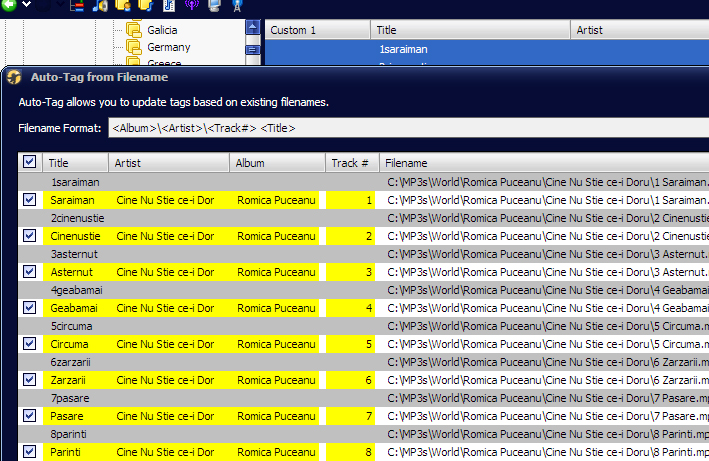
The yellowed fields have been filled in automatically from the file and folder names according to a simple rule
Of course, it can write these changes back to your MP3s. Not just your MediaMonkey library but also your collection itself can get organised.
Case Checker
If, like me, you’re truly compulsive about having your collection correctly labelled, this feature takes care of all your capitalisation needs automatically:
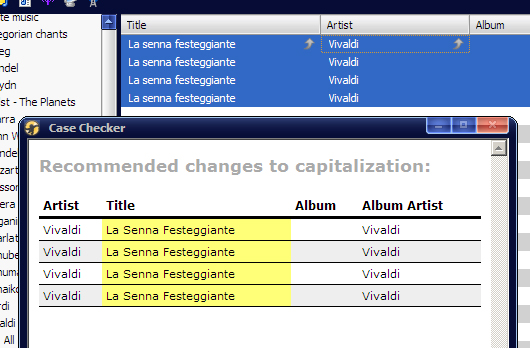
Now, this is only a script (see below), albeit one that’s popular enough to have been installed by default. But how cool is that? It even takes care of words not normally capitalised, so you’ll get “Minnie the Moocher” (but “The Mooche”).
Tree
If you like, you can display your library in a tree structure, and navigate that structure to find music in various ways. For example:
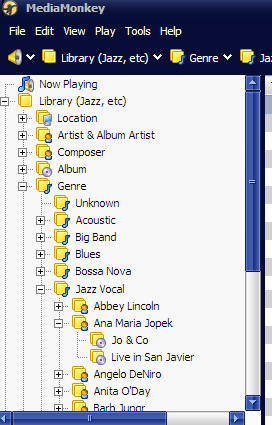
Here, I’ve opened my “Jazz, etc” library[1] and opened the “Genre” node. Nodes below that are automatically generated on the basis of “Genre” tags in the library tracks. Opening the “Jazz Vocal” genre, I get a list of artists, again based on tag info found in the library. Ana Maria Jopek is there; opening that node shows the two albums of hers I have which contain tracks with the “Jazz Vocal” genre. I have more albums by Ana (she’s damned good!), but they have other genre tags, and so appear elsewhere. This all works beautifully.
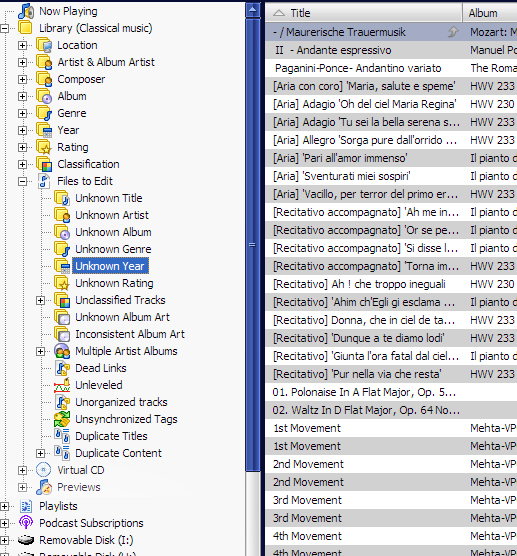
Here, the “Files to Edit” node is open, as is the “Unknown Year” child node. Both of these – indeed, all nodes in this screenshot – are automatically generated. The tracks in the edit window on the right are displayed according to the tree on the left; in this case, those tracks with no “Year” tag value. I’ve included this screenshot to give an idea of how much information is available from the tree – how many MP3 players let you browse your library on the basis of “inconsistent album art”, for example? If I were thirty years younger, I’d say this r0x.
Volume levelling
No screenshots for this feature, because there’s not much to see, but it’s well worth describing anyway.
You can, if you want, scan tracks – your entire library if you like – for volume levels, and MediaMonkey can then balance them so your output volumes are consistent. You can do this per album if you like, so that balance within (say) a symphony is maintained, or you can do what I did (no doubt incurring the wrath of audiophiles) and balance all the tracks independently of one another.
And having done that, you can even have MediaMonkey change your MP3s, FLACs and so on so that their native volume levels are consistent. I’ve not done that, but it’s there.
Searching
There are two “Search” methods in MediaMonkey – a simple one, accessed from an optional toolbar, and a more complete one. Together, they an extremely powerful way to navigate a large music collection. Note that I’m coining terms here – I can’t find any “official” ways to differentiate the two.
The simple search isn’t exactly elementary either. Dig this mouseover help:
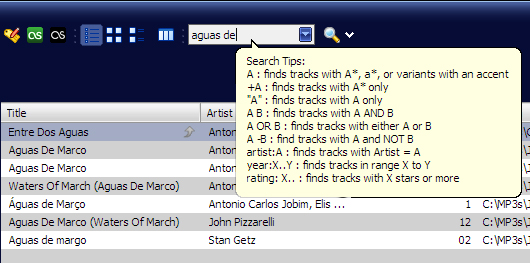
Geek heaven. And that’s only the basic search.
The complete search lets you filter on pretty much anything, on either the “Basic” tab:
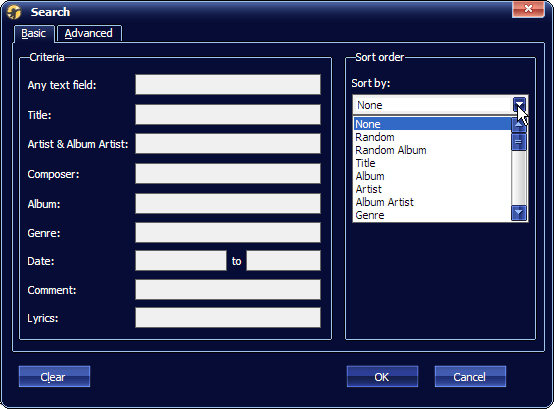
or the “Advanced” tab:
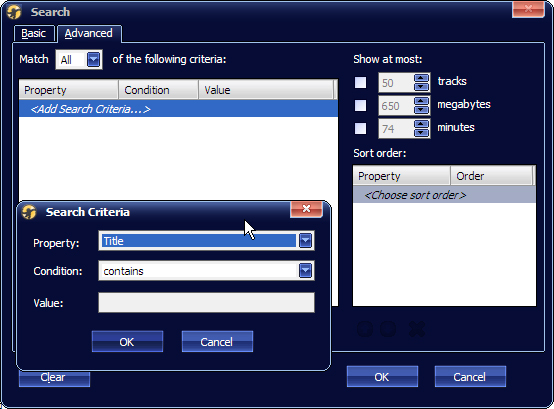
The dropdown for “Property” includes every possible tag, and a few non-tag items like pathname and size.
These searches are quick, too – MediaMonkey isn’t going through all your files on disc, it’s simply executing an SQL query on your library data.
And, having searched, you can then do anything you want with the results – make a playlist, change tags, delete all the files. So, you could assemble a list of all your Country & Western tracks which have the word “lonesome” in the title and last longer than five minutes, and burn that to a CD to give to your boss. MediaMonkey can be used for evil as well as good.
Scripts
Sometimes it seems as if the MediaMonkey team have thought of everything, but of course that ain’t so, and individual needs can vary to an amazing degree. So, as well as various plugins, users submit their own scripts (hundreds of ’em) to do anything from further organising your collection to adding new nodes to the tree, to giving more playing options. And, of course, you can create your own scripts, which is just about the cat’s nightwear as far as I’m concerned.
Conclusion
This is a powerful, robust and mature piece of software, and I don’t know how I ever managed without it. To say it’s revolutionised my music listening is no hyperbole – I’m hearing my collection how I want it. Winamp may claim to “whip the llama’s ass”, but let’s put it this way: you’ll be picking pieces of llama off your walls for weeks to come when you try MediaMonkey.
The features I’ve listed here are only a few favourites – MediaMonkey is capable of far more. See the MediaMonkey Wiki for more complete information. Chances are, if you’ve got a feature you’d like, MediaMonkey will either have that feature, or a script will already exist with it.
And it’s free. Not some crippled version with nag screens, but free as a complete product. Registering the Gold version simply adds a few nice features, such as multiple libraries, and gives a big “thank you” to the dev team. And this post too is a thanks to those hard-working, talented and generous guys, whoever they are.
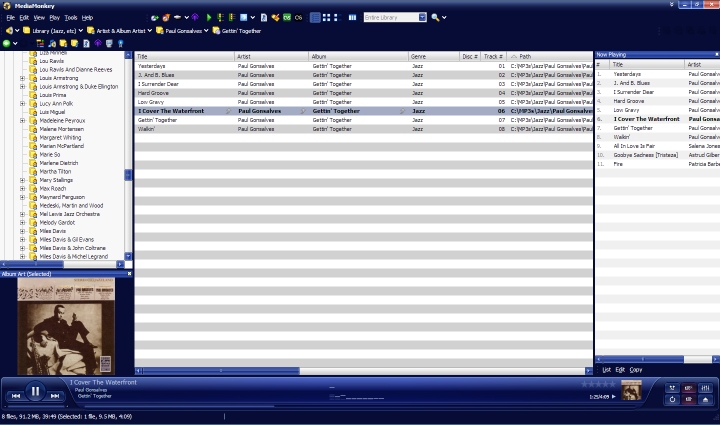

those generic mp3 players that are made in china are really cheap but i still prefer to use my ipod ‘”,
I dunno, I’m using a Sandisk Sansa Clip+ 8GB, and it sounds better than any iPod I’ve heard, costs considerably less, holds considerably more, has more features, and so on. MediaMonkey feeds it with MP3s very easily and quickly and in a highly configurable way.